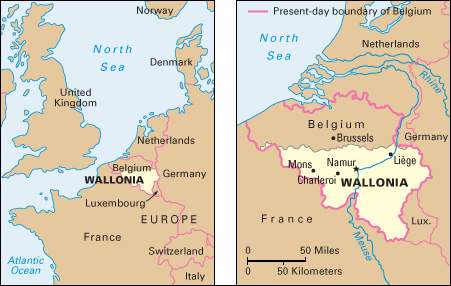Wallonia is one of three official regions of Belgium. The other two are Flanders and Brussels. Wallonia covers the southern part of the country and includes the provinces of Brabant Wallon, Hainaut, Liège, Luxembourg, and Namur. Wallonia is the least densely populated of the three regions. Rolling hills cover the northern part of the region. Plateaus, river valleys, and the wooded hills of the Ardennes define the east and south. Cities, where most of the people live, cover the northern landscape. The name Wallonia comes from the Germanic term Walh, which means foreigner. The people of Wallonia are called Walloons.

Like Belgium’s other regions, Wallonia has its own prime minister and parliament. The region’s capital city is Namur, and its official language is French. In the late 1800’s and early 1900’s, disagreements grew between the French-speaking people in southern Belgium and the Dutch-speaking people in the north over official language use in government and higher education. In 1932, the government made the official administrative language French in the south and Dutch in the north. Between 1970 and 2001, further reforms established Wallonia as one of Belgium’s three political regions.
Walloons are well known for their achievements in the arts. The composer Johannes Ciconia, born in Liège, popularized the musical concept of counterpoint (multiple melodies performed at the same time) in the 1300’s. Adolphe Sax, a Walloon instrument maker, invented the saxophone about 1840. During the 1920’s and 1930’s, the Belgian artists René Magritte and Paul Delvaux began painting Surrealist works, which combined ordinary scenes and dreamlike images. Georges Simenon, born in Liège, wrote popular detective stories through much of the 1900’s. Walloon artists also created such popular cartoon characters as the Smurfs and Tintin.
During the 1800’s, Wallonia’s waterways and abundant raw materials contributed greatly to the growth of industry. Industrial leaders in the region included John Cockerill, a steelmaker, and Ernest Solvay, a chemist and manufacturer. By the late 1800’s, the Walloon cities of Charleroi, Liège, and Mons had become centers for the coal and iron industries. During the 1900’s, however, industry in Wallonia declined significantly. The region has since struggled with high rates of unemployment, especially in the steel industry.
See also Walloons
